„You can't be an Englishman if you have no English relatives”
DNA tests became very popular in the last 10 years, mostly driven by the sharp decrease in the prices charged by the main suppliers. These tests, based on your genes, provide details about your ancestry, projections about probable future health issues and some other interesting details.
But: Are these tests the same in terms of the quality and reliability? How should someone choose between the available options? In the below article I try to compare the two tests and share some of my very interesting findings with them.
But before that, please accept some description about the genetic history of Hungary and my family.
The ancestry of Hungary
Hungary, as most of the countries, was always a melting pot of different nations, people with diverse heritage. Already the first Hungarians arriving to the Carpathian Basin were a strong alliance of seven tribes and based on several research their genetic background was diverse. The original Slavic population continuously got mixed up with the prevailing Hungarians. During the first five centuries of its existence after 1000 AD, Western Asian tribes settled in the Hungarian Kingdom. Thereafter, Turks dominated the majority of the Country for 100-150 years. After the end of their governance, the Austrian Empire enhanced the resettlement of the previously depopulated country. Germans, Serbs, Romanians were settled down from the 18th century. Askenazi Jews from Eastern Europe also arrived to the country from the early 1800s at an ever growing pace. The explosive development of Budapest to a metropolis also gave rise to migration, especially after 1867. Immigration from Hungary also took place paralelly to America in the 1800s and early 1900s, to Israel after the Holocaust and to Western Europe during the Soviet communist dictatorship and after the liberalization of the employment opportunities in the European Union.
My family ancestry
My family history duly represented the above diversity. My father's family from his father side was told to be Germans. My grandfather was born in Tótvázsony, north to the Balaton lake, which provided great opportunity for agricultural and winemaking activities. My grandfather's father was born in New York City, but their family was originated from the Rhine region in Germany. His name was French, which indicated that the family was derived somewhere from Rhineland-Palatinate, Saarland or the Grand-est region is France or perhaps from Nordrhine-Westfallen. We had no details about the heritage of my grandfather's mother aside from her German name and tradition.
My father's mother is from the tiny village of Felsőtold from Nógrád county. Most of her ancenstors' names were Slovak, while her family name was Austrian. Endogamy was widespread in the region. My estimate before the test was that her heritage was 80% Slovak and 20% German.
My father had a German outlook, with blue eyes, white skin and strong intolerance to hot temperature, which I fully inherited. He was ill with melanoma at his age of 35 but successfully recovered. He was not tall (172 cm) and could generally be described as a „South German” person. Some of his family members shown some harsh North-European characters with very white skin, redish hair and very blue eyes.
Alltogether I assumed my father to be 60% German and 40% Slovak (Eastern European).
My mother on the opposite (below 160 cm) was quite a Southern character in clear Balkan style and other oriental patterns from Western Asia.
Her father, born in Budapest, was half Jewish (her family name sounds German but clearly in Jewish-style), while her father's mother had a Slovak name. Based on the picture I saw, she might have had some Southern European ancestry, as well. Her Jewish grandfather was not a typical Jewish-style face (only turned that way in his old age) and my mother much more clearly shown these characters than either his father or his fully Jewish grandfather.
My mother's mother was fully Hungarian from the Tapolca area in the beautiful Káli Basin to the Northwest of Lake Balaton. Her family name was an old Hungarian one and her outlook was also Southern. My estimate was that her old Hungarian predecessors had some Western-Asian ancestry.
My Estimate before the test was made for my mother was 50% Hungarian (Eastern Europe, Balkan), 25% Jewish, 20% Slovak and 5% Southern European.
Alltogether the above would give an estimate on my heritage, as follows:
25% Hungarian, 30% German, 30% Slovak, 12,5% Jewish and 2,5% Southern European.
My first meeting with genetic tests: I saw it and purchased it immediately.
I was always curious about ancestry, so the well-prepared video I saw in March 2019 immediately forced my to purchase a test from MyHeritage, without having any background knowledge about either the company or their services.
I purchased the test for 78$ plus the posting cost for the sample was 2$.
The sample-taking technique of MyHeritage is very comfortable and easy to deliver.
The result arrived in 7 weeks after the posting of the DNA sample and the result was breathtaking.
The result explained a lot about why I spend most of the time in the summer at home and why I wear always less protecting clothes from the cold than 99% of the people in Hungary.
MyHeritage – with its focus database to Europe, Israel and the jewish communities worldwide, incl. the USA – provided extreme number of relatives. Today I have 7970 relatives (all distant) of which 135 in Hungary, 100 in Israel, over 3000 in the USA and 375 in the UK.
Results and features in MyHeritage
I was naturally surprised about the English and Celtic heritage indicated by the results but for first look data seemed reasonable. Most of my relatives are located in the US (3075) but the number of my UK relatives is also very high (375), only the comparative number in France (448) is higher and exceeds even the Germans (363).
The dashboard of the results is easy to follow, it's possible to select relatives also by ethnical group (ancestry) or location. The ethnicity estimate is demonstrated through a very charming short film with the earth showing the ethnical region along with typical music linked to the geographical areas.
The most useful part of the test is the relative finder feature. Relatives are shown in the sequence of shared DNA %. Freely shown data per relatives:
-
family names
-
the closest common third relative
-
the most common ethnical group
-
common DNA parts in a visual layout, showing chromosomes top down from 1 to 22.
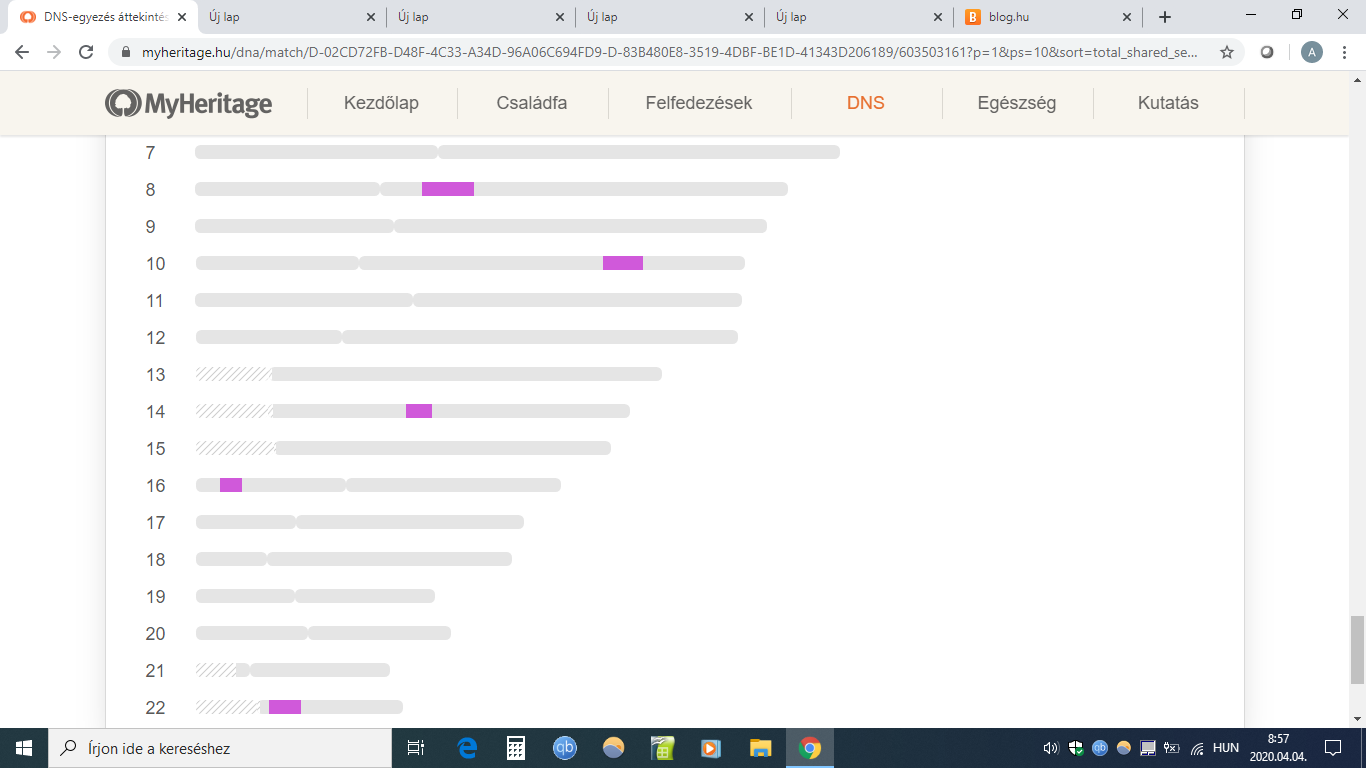
Relatives can alternatively be filtered per the number of common DNA sections or the lenght of the longest common section, as well. This last is the clearest proof of common ancestry. For annual subscription the entire ethnical estimate of the relative can be viewed along with his/her whole family tree available.
Why I became sceptical about the results of MyHeritage
After having received the enthicity estimate and gained access to my DNA relatives, I've invested quite a long time to review my closest relatives one-by-one. After reviewing the top 100 relatives, it became clear that approximately the 95% of them is a relative (at least partially) from the Askhenazi Jewish heritage pool. The few exceptions were either users with Hungarian residence or ones with clear Hungarian ancestry. There was only 1 of the Top 100 relatives who had high % of English ancestry and with whom I shared long common DNA. Getting a bit more familiar with ancestry, I've found some reasonable explanations for this overrepresentation of Jewish relatives among all.
For first, MyHeritage is an Israeli corporation having strong presence in the Jewish communities, not only in Israel but also in the US. A strong message of promoting MyHeritage tests is that through the membership an uncomparably large Jewish relative pool becomes accessible. Through this access, more information about unknown or missing family tree details may become available. I personally obtained lots of new information about the history of the Jewish part of my family with the assistance of a newly found third cousin. Before my test was completed, all I knew was the name of my great grandfather. Right now, I know the names of all of his grandparents back to the early 19th century.
For second, genetic diversity in the Jewish community is very little. Based on genetic research, the Askhenazi Jewish community, as a result of persecution and expulsion, suffered huge losses about 6-700 years ago and the current population worldwide of 10+ million is the descendant of a few hundred „founding” individuals. Other populations like English descend from millions of individuals back to the same 600 years.
As a result of the much higher diversity, the chance to find a close relative out of the same number of users from other ethnicities gets much lower.
Based on the above, at that time I did not expect that the ethnicity estimate of MyHeritage is fundamentally wrong. Having 1900 Celtic and 1350 English relatives, the estimate looked reasonable despite that very few closer relatives came from these ethnicities. I assumed that the historic distance of my old forefathers reduced the common DNA per one individual, despite that their genes related to their ethnicity remained significant. At the same time I started to be sceptical, seeing the high number of users in the USA, also knowing the very high English overall ancestry there. Knowing these, the chance to find almost no real relatives out of my 28% English and Irish genes also looked very odd.
The next inconsistency: relatives with no common ethnicity
When gaining access to the existing 5000+ relatives, you'll never have the chance to review your very far relatives. However later, when new relatives join the database, you'll have the chance to check the daily 10-20-30 new relatives one-by-one, in case you have 20 minutes a day. Through these daily checks I became aware that quite frequently I found relatives with whom I didn't share a single common ethnicity. These relatives in general came from either Germany and the surrounding countries with „Northwestern European” (French, German, etc.) or Eastern Europe with „Eastern European” ancestry. Generally I shared 0,2-0,3% DNA with these far relatives. After the first couple of such cases I contacted the customer service of MyHeritage, seeking explanation about this phenomenon. MyHeritage provided a response, which absolutely did not answer my question and contained only general things.
Later I could separate such cases to 2 groups: in the first group, German and Eastern European relatives were found, which meant to me that my enthicity should contain some of these ancestries, but maybe its proportion was small for the test to show. The other group contained people, with whom I shared a Jewish relative, despite that their ethnicity estimate did not contain any Jewish ancestry. These relatives came generally from Belarus, Poland and other Eastern European countries, but occasionally even from South America. Finally I've found a relative with 100% Irish, Scottish and Welsh ancestry with whom I shared the closest common relative with 98% Jewish ancestry. Needless to say that it looked almost impossible that a person with 100% Celtic DNA and me with 11,1% similar DNA do not have any closer relative other than a 98% Askhenazi Jewish user.
The final motivation to test my ancestry through an alternative supplier arrived when my wife's DNA test results became available. We assumed her ancestry to be dominantly Eastern European with strong German influence, along with 5-10% Jewish ancestry on the sideline. On the contrary, her result contained 56% Balkan, 19% Scandinavian, 15% Eastern European, 0% German and 0% Jewish heritage. At the same time, she has found 10 relatives in Israel, out of which with 8 she did not share any common ethnicity.
I also came to know the test results of a couple of other users (friends) with similar unexpected Scandinavian and other exotic ancestries with no German ancestry, despite knowing the Hungarian history with clear and direct connection with the German but almost no connection with the Scandinavian or the English population. After all these inconsistencies I felt to be cheated and wanted to doublecheck the results provided by MyHeritage.
After checking the available options on the internet, 23andMe became my choice to do that, reviewing their services, the variety of analyses provided (incl. maternal and paternal haplogroups, etc.) and the other things I'll describe later on.
My second ancestry test: 23andMe
23andMe is the market leader ancestry service provider in the USA with over 10 million DNA tests and users, hence it surpasses the database of myHeritage about 7 times in terms of the number of tested users. 23andMe focuses primarily on the US market and is not really well known elsewhere. The general price for the ancestry service is at 99$ and is very rarely promoted, in opposition to MyHeritage, where there is a discount most of the time. Even more painful for European users that price promotions do not apply for non-US customers. With shipment, the price for European users can add up to 130$.
The way I purchased the service was a bit tricky. A friend of mine just moved back from Houston and when promotion was offered, he ordered one set for himself and one for me and brought my kit personally to Hungary. As the US kits can not be posted from outside the US, I also needed his support to arrange its take back to and posting in the USA, which service was provided by a Hungarian friend who spent the Christmas Holiday in Hungary and then travelled back to Houston in January 2020. My final price of 84$ therefore required lots of assistance and co-operation from others, for which I am very greatful.
The sample taking technique of 23andMe compared to MyHeritage is annoying and disgusting. The saliva collection kit required from me 20 minutes to spit into a little plastic tube (about 50 times), my mouth became very dry (almost bleeded) and the replacement of the screw on the top was so difficult that I almost poured out the sample coincidentally. I'm sure that there is a scientific reason why 23andMe prefers this technique, but I think they really should consider other options one more time. It's also possible that this sample taking technique is about to prevent children or other unintentional users from taking their DNA by someone else without their approval, as producing this volume of saliva requires lots of efforts. However, there should be some other ways to protect these potentially effected (unintentional) users, without requiring all the intentional users doing this very demanding exercise.
As a result of the adventurous way to send the sample back I had to wait months for the result, but after having received it, that was really worthwhile in the end.

Let's compare the tests to each other:
| MyHeritage | 23andMe | |
| Eastern European | ||
| Balkan | 50,1% | 0,0% |
| Eastern European | 0,0% | 32,9% |
| 50,1% | 32,9% | |
| Northwestern European | ||
| French and German | 0,0% | 23,0% |
| English and Irish | 28,0% | 0,0% |
| Scandinavian | 2,0% | 0,0% |
| Finnish | 2,0% | 0,0% |
| Broadly Northwestern European | 0,0% | 9,3% |
| 32,0% | 32,3% | |
| Southern European (Greek, Balkan and other) | 0,0% | 4,0% |
| Broadly European | 0,0% | 11,7% |
| Jewish and Arab | ||
| Askhenazi Jewish | 17,9% | 17,2% |
| Arab, Egyptian and Levantine | 0,0% | 0,7% |
| 17,9% | 17,9% | |
| Others | 0,0% | 1,2% |
| 100,0% | 100,0% |
Based on the the above the easiest finding to make is that the Jewish heritage is accurately the same in the two tests. Despite that lower % Jewish heritage is sometimes underestimated by MyHeritage, on this % level their measurement is accurate. The difference in Jewish vs Arab classification is easy to assign to one section on chromosome 5. As 23andMe does not have a separate ethnicity cluster for the Sephardic and Yemenite Jewish communities, my assumption is that this DNA piece is coming from a predecessor of mine from one of these communities either from the Turks' time in Hungary or the few Sephardic Jews who passed through Hungary in the early 18th century. As a result, this piece can also be found in a small part of Askhenazi Jews and it's not a mistake to count that into that genetic pool, as MyHeritage did. This gene part is common with one of my closest US relatives (with 96% askhenazi jewish estimate), but it's true that no other top 100 relatives share this piece with me.
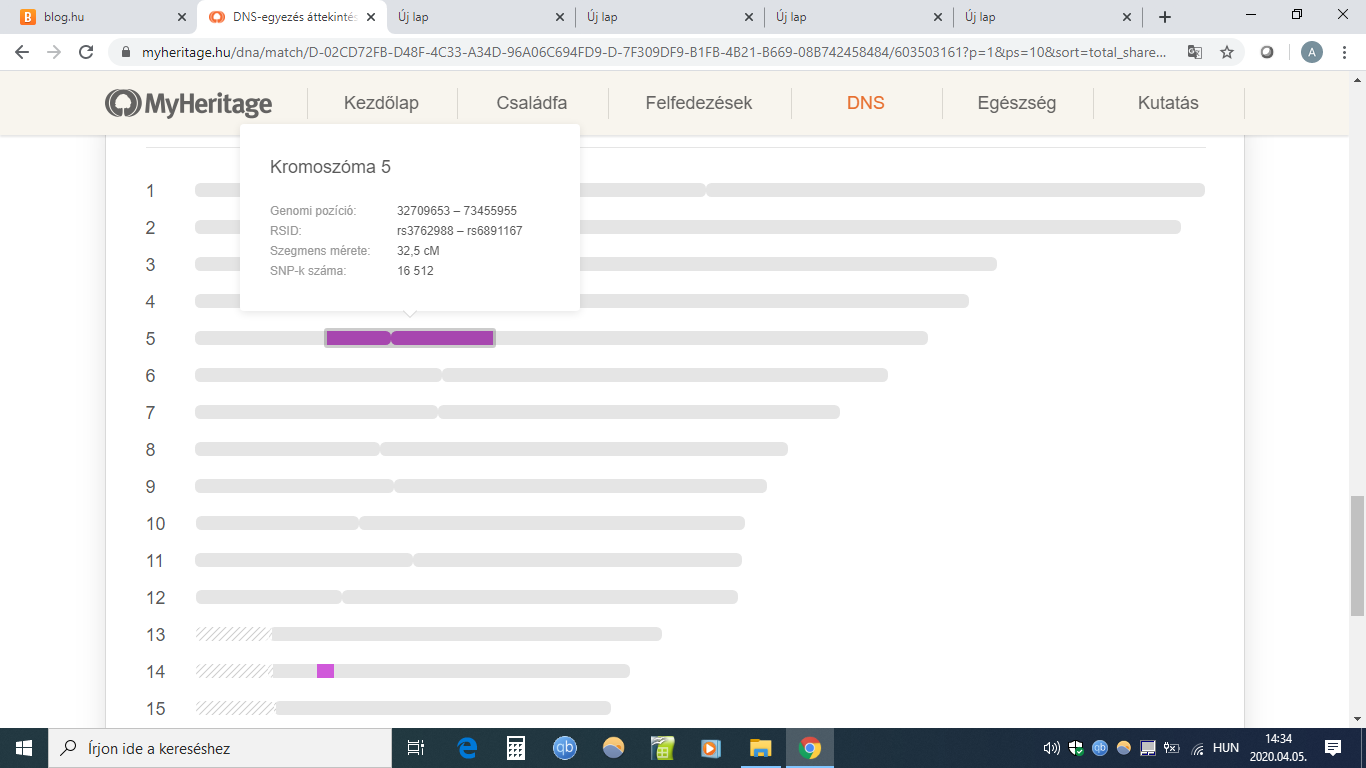
It's also easy to see that the overall Northwestern European estimate by MyHeritage is also correct but with completely wrong subregional breakdown. As the 23andMe estimate confirmed the Rhineland-Palatinate region in the test, in line with our family history, it must be correct and MyHeritage must be wrong. Probably the genetic distance between the Northwestern European populations is not that high and MyHeritage clearly does not have a big enough database to separate that effectively, therefore they draw incorrect conclusions from those. On the contrary, 23andMe knows the US customers with their very high proportion of British and Irish heritage well and therefore their knowledge is as reliable as the Jewish estimate provided by MyHeritage. MyHeritage presumably checks minor SNPs in the DNA to trace ancestry while 23andMe has a record of whole sequences of typical human DNA per region. But while 23andMe can use that for reliable test results, MyHeritage misunderstood the important genetic markers of the Western European ancestries, therefore they overestimate the British, Irish and Scandinavian heritage vs the French and German genetic pool. There is no problem with this until when German world cup winner, ex-nationalelf football players are confused and believe that they had played for the wrong country, while actually they didn't ( https://www.youtube.com/watch?v=FKN7jHk1jn0&t=527s - you can see this part from 6:00 in the video).
It's also clear that the "Balkan" estimate of 50,1% by MyHeritage contained all the Eastern, Southern and broadly European ancestries in aggregate. Probably they looked at the markers in general and took their average. With lots of eastern and some southern European markers they averaged that into the Balkan peninsula. You can also see that gene parts that can't be assigned to certain subregions, MyHeritage assigns to the highest % of ancestry, in my case to the Balkan ancestry. The high "broadly European" portion in the 23andMe test, per my estimate, should partially be equal to the unique Hungarian genetic variants even 23andMe could not detect so far, based on their low number of users from the country.
I also like the way 23andMe is willing to use "other" categories and accept that some DNA pieces they can't assign to subregions. Of my 9,3% broadly Northwestern European genes, I am sure some come from the Finns, while others are old Celtic genes, either from the British Islands or from the early medevial times they were united with the Germans. However, as these parts of genes were absorbed thoughout Europe, that can not be called their unique genes any longer.
Everyone seems Polish in Hungary. Is that so?
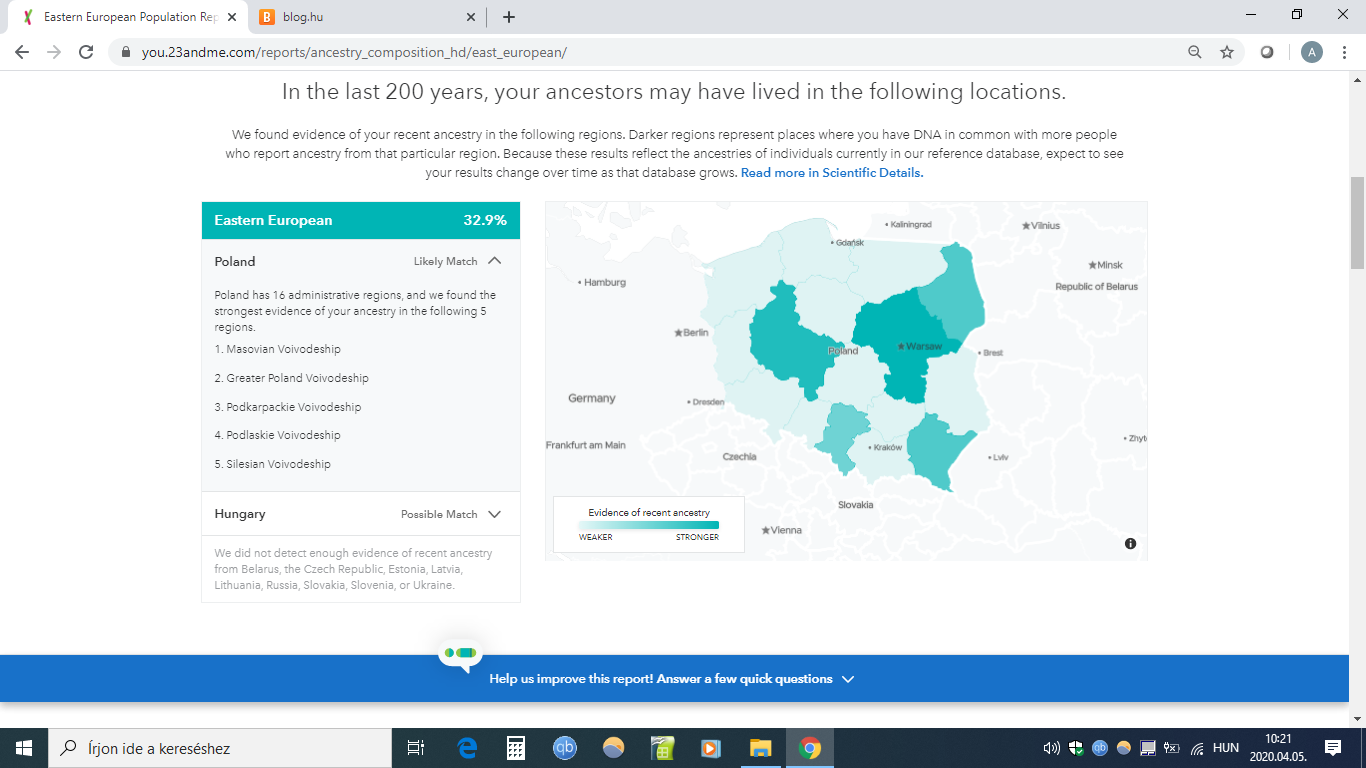
Aside from myself, I've seen 3 genetic test results of Hungarian citizens from 23andMe. For all the 4 tests, Eastern European ancestry was geographically linked to Polish Voivodeships and no other countries. Why may that be? I think we'll find some good reasons for why that's the case.
As described earlier, 23andMe has a clear focus on the US market. The Polish diaspora is well known to be high in the US at some 10 million individuals included. Without having a detailed genetic study over the Polish regional genetic variants, 23andMe could not provide meaningful results for its US customers. Poland in Europe with its population of around 40 million in itself is a significant enough country to analyze even without the Polish diaspora in the US, but indispensable also knowing that. However, Slovakia with 5.4 million or Hungary with 10 million inhabitants looks not that much interesting to invest into genetic studies. What simply happened is that 23andMe undertook extensive sampling in Poland but presumably nothing in the other regional countries. As I described in the Hungarian history part, Hungarians always got married with Slovaks, while Slovaks are the close relatives of Polish and probably (being the neighbors of each-other) they also got married to each-other over the centuries. I think that if 23andMe analyzed the Slovak genetics itself, Hungarians would suddenly be linked to the Slovak regions instead of the Polish Voivodeships. Nontheless, Hungarians and Polish are the best friends and naturally – through Slovaks - are in far genetic relationship to one-another.
To prove the trueness of the above, an important comparison of my MyHeritage results: I have 47 Polish and 28 Slovak relatives, while Poland is 8 times bigger in population terms than Slovakia. Some other reasons go against my logic: 1. Jews in Poland were fully eradicated, while I may still find some remaining Jewish relatives in Slovakia. 2. The Hungarian minority adds up to the 10% of the population of Slovakia, which increases the number of relatives for a different reason. 3. Poland legally prohibited the collection of Polish DNA by international companies, therefore the number of users is uncomparably lower than other countries.
Despite the above, I think my explanation is still valid and described the real reason behind this topic.
My German ancestors came from these regions in Germany
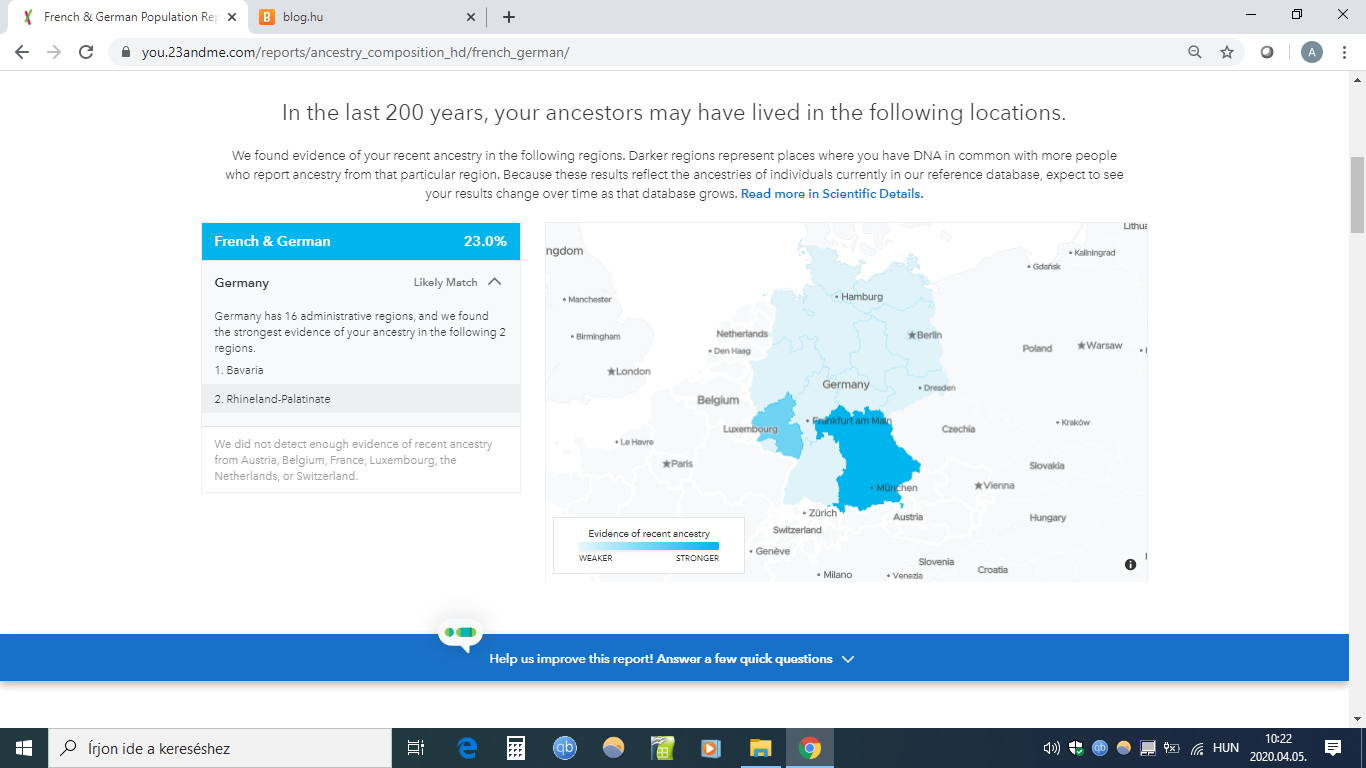
The Holy Grail of all genetic tests: The coloured DNA map

If I should mention the most breathtaking thing in the DNA tests, I would mention this DNA map without any hesitation. This map demonstrates how deeply 23andMe understands the human genom and how well they are able to link each sections to enthnical groups. Here it's really worth zooming the laptop's screen to 250-300% and checking how small sections 23andMe is able to link to different ethnicities. This does not mean that 23andMe has a full set of the entire human genom for all the 7 billion people. This analysis still contains speculation and estimates. However, their database is still reliable enough to let them provide this analysis with full responsibility, as if this contained huge mistakes, that could be easily identified by their competitors.
This map shows on each chromosomes the DNA heritage from your parents. The analysis can not tell you which of the pair of DNA comes from your mother and your father and there is no consistency like always the upper comes from the father, as 23andMe does not know this until one of your parents also orders a kit and his/her result becomes available. What we know is that one line of the pair of your DNA comes fully from one parent and the other from the other.
This presentation also provides a lot of extra information. For example in my case it turned out this way that my father – who had some antisemitic bias – must have had at least a tiny Askenazi Jewish heritage himself, as on my chromosome 16 both lines contain a small jewish piece. This analysis also highlights that my mother, whom I considered to be southern with no western heritage, passed on to me significant Western European ancestry. I also learned that my 4% Southern European ancestry came from both of my parents and not only one of them. And we can continue the listing of the findings using this magnificent tool.
Comparing the two tests after learning the details
For first, based on the above it's clear that my opinion will be that 23andMe should be used in case you want to know the most accurate analysis about your ancestry. No full analysis can ever be made as your DNA is only a composition of your ancestors DNAs and through generations lots of important details are not passed on, as those disappear.
I also prefer 23andMe in terms of its purpose and the way they try to sell extra services. MyHeritage always tries to sell annual subscription for gaining access to family trees and the full ancestry of relatives (this last thing for 23andMe users is free), while 23andMe only offers the „Health” extension but in a much less pushy way.
However, a very important factor was not mentioned yet: of the more than 10 million users of 23andMe I only have 1355 relatives, less than the 20% of the comparable number of MyHeritage, despite that their database is 7 times bigger. This means that the probability for me to find a relative in MyHeritage per 1 million user is 35 times higher than in 23andMe, which is logical, as American customers have dominant British and Scandinavian ancestry that I do not possess. I assume that jews in the USA more tend to prefer MyHeritage to 23andMe. Even more important that in the 23andMe database I have only 1 relative in Hungary and 15 in Israel, while MyHeritage provided 135 Hungarian and 100 Israeli relatives for comparison. Living in Hungary with some jewish heritage, MyHeritage can simply not be disregarded in case you want to find relatives you don't know.
For completeness sake, I also have some areas (aside from the sample taking method) where I prefer MyHeritage to 23andMe. One area is the presentation of common DNA sections, which is quite poorly presented by 23andMe. I also miss that common DNA parts could easily be assigned to the DNA map and so that could also contain the common ethnicity of each common parts but it doesn't. I also dislike that while MyHeritage by default shows the DNA details of the relatives unless they block that, in 23andMe you need to seek this from your relatives and they very rarely allow you to do that.
Looking backwards I'd say that the 2 tests together are THE PERFECT ONE SUPER TEST for me, as based on the DNA map of 23andMe I can very easily translate my lots of MyHeritage relatives to ethnical groups, which previously I couldn't. For instance, my only „British” relative of the MyHeritage top 100 is actually a German relative, as our common section on chromosome 21 is probably a German part there. But if not, then it must definitely be the Jewish part on the other side of that same chromosome.
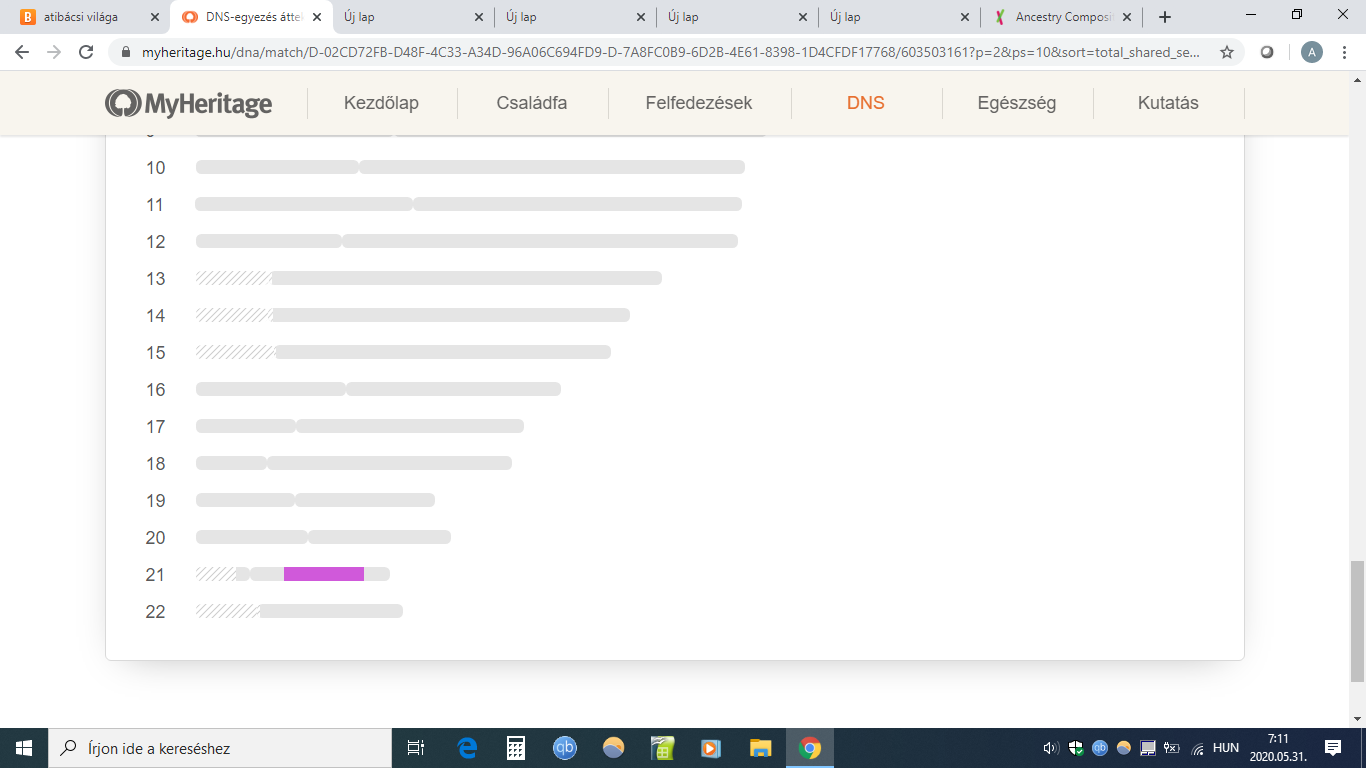 By now it's also clear that my great number of MyHeritage relatives from England is explained by the sizeable jewish community in the UK.
By now it's also clear that my great number of MyHeritage relatives from England is explained by the sizeable jewish community in the UK.
One last interesting finding
Another friendly feature provided by MyHeritage is that you can upload your DNA from tests ordered from other providers. That's what I did and the consistency between the two tests was 99,7%, only 3 of every 1000 genes were read differently. Concerning that this is not a police investigation, but only a cheap test, we can accept this as a tolerable variance. However, there is something I realized in the meantime. When checking the common sections between my 2 users, the main gap between the two can be found at the narrowing part of chromosome 2.
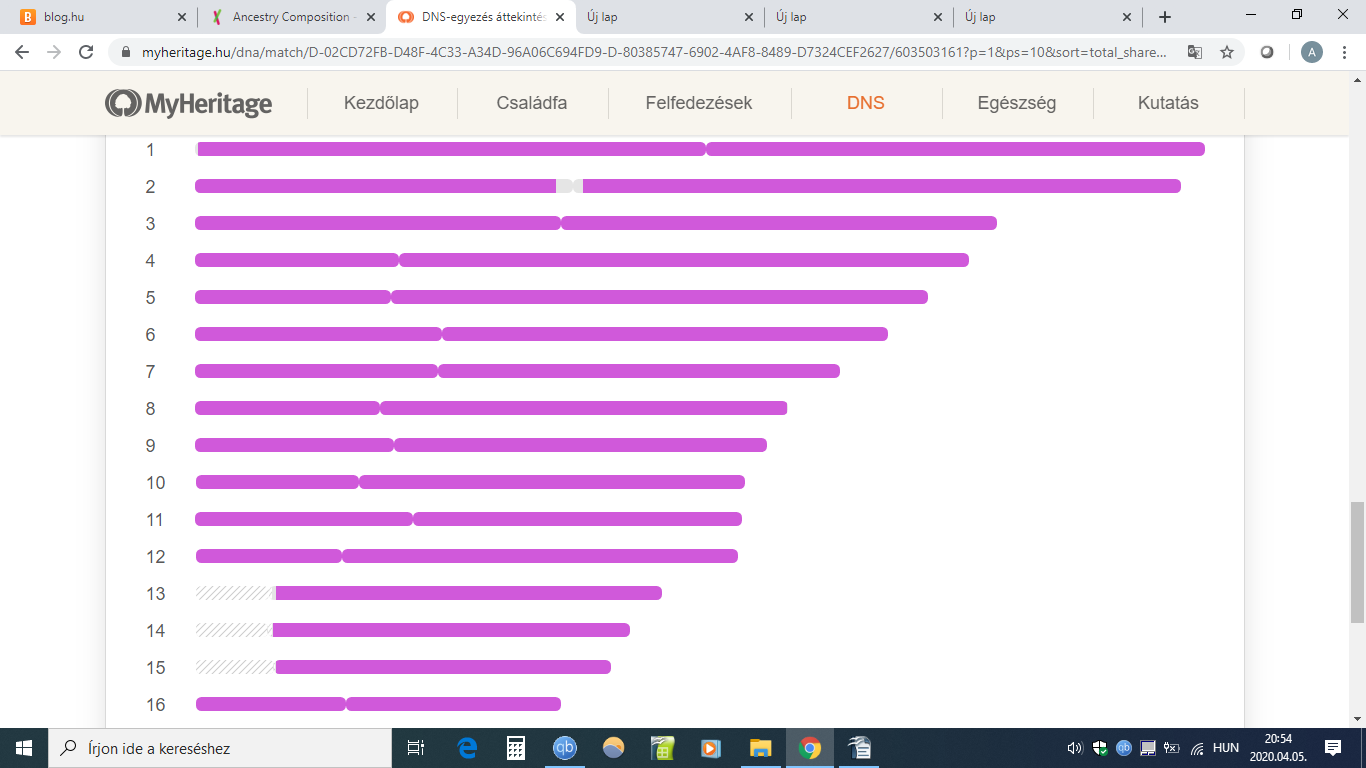
But thinking further, I realized that this area is familiar from somewhere else. My wife has a close Austrian relative with whom she has 2 common sections on this very chromosome with a gap in between.
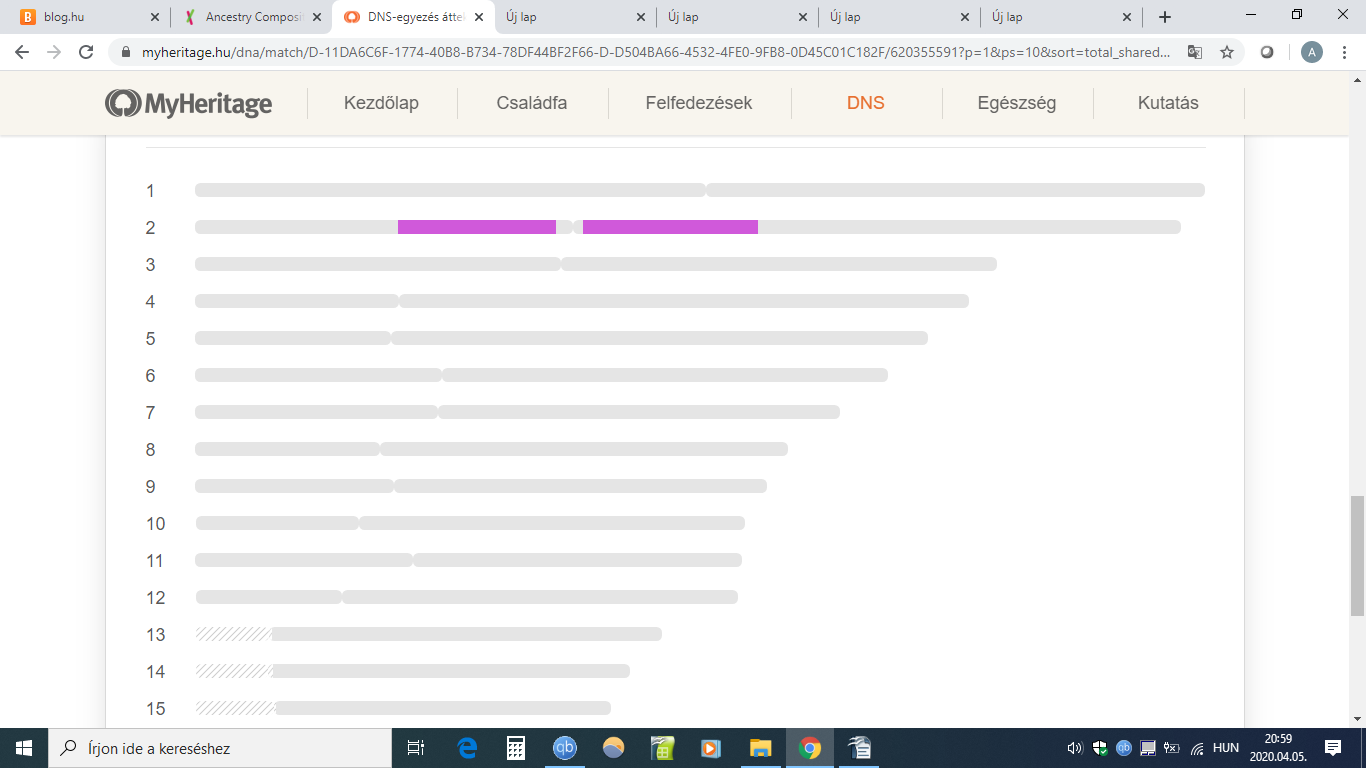
Of course this might only be a coincidence, but to me it looks something else. As 23andMe and MyHeritage read different DNA information based on my same DNA and my wife's relative's DNA shown a difference also on the same area, my conclusion is that the reading technique (chip) of MyHeritage makes a consistent mistake on reading this part of the DNA. This is not a huge problem, unless you order a health extension (which I did) and some of your genes (taken into account for genetic risks) come from this very part of the DNA.
Uploading your second set to MyHeritage is actually not a very good idea, as from then on the common closest relative of yours with any other relative will be your other set. Therefore it's wise deleting the other set once you've checked that as much as you wanted.
Final thoughts
It happened a year ago when I first heard about the existence of such genetic tests and the above shows that this year was full of great experiences and this journey enriched me with some insight into a new world, that teached me a lot of new things. At the same time I see that there is a long way ahead of us to improve the quality of these tests, but what we have right now is already a lot.
Let me share one final examination with you: When checking my relatives in 23andMe I realized that NONE of the top 100 MyHertage relatives can be found in the 23andMe database. It seems that almost no-one orders this test from different suppliers. Until now I haven't found a single relative in both systems. It seems that people are happy with their system and do not try others. This seems to work like religion: you do not join a catholic, a protestant and a jewish celebration. The above shows that they should probably do.
Update to the original article
In October 2020, 23andMe provided a modified ethnical estimate, as follows:

Main changes:
i, Eastern European +12%, Northwestern European -9% (now German only, no broadly NW European remained), broadly European -3%. This revised result increased the reliability of the original MyHeritage Eastern European (Balkan) estimate of 50,1% and - even though changes made for accuracy purposes - reduced in general the reliability of 23andMe severely.
ii, East Asian portion fully reclassed to Askhenazi Jewish/Eastern European: Probably these (0,5%) genetic variants in my DNA were new for 23andMe.
iii, 0,7% reclassed from Southern European to Turkish (Anatolian), minor further reclass from Balkan to Italian in Southern Europe.
iv, Egyptian estimate is specified to Coptic Egyptian/Christian (non-jewish DNA). There was a Coptic quarter in the Buda Castle during the Turks' time (1541-1686), so the 0,7% Anatolian + 0,6 Coptic may have had been my 5th great grandparents (they probably assimilated into the Jewish community as their remaining genes are probably located on my DNA received from the mother side).
v, The Eastern European regional estimate for origin extended with Budapest (does not look logical based on my family history, more probably my relatives now live in Budapest but are not originated from Budapest). Poznan became the closest Polish region of relatives instead of Warsaw.
vi, Saxony arose as a new region of origin in Germany (less close than Bavaria or Rhine-Pfalz).
Generally the above shows that the 23andMe database is by far not as reliable as it looked 6 months ago...